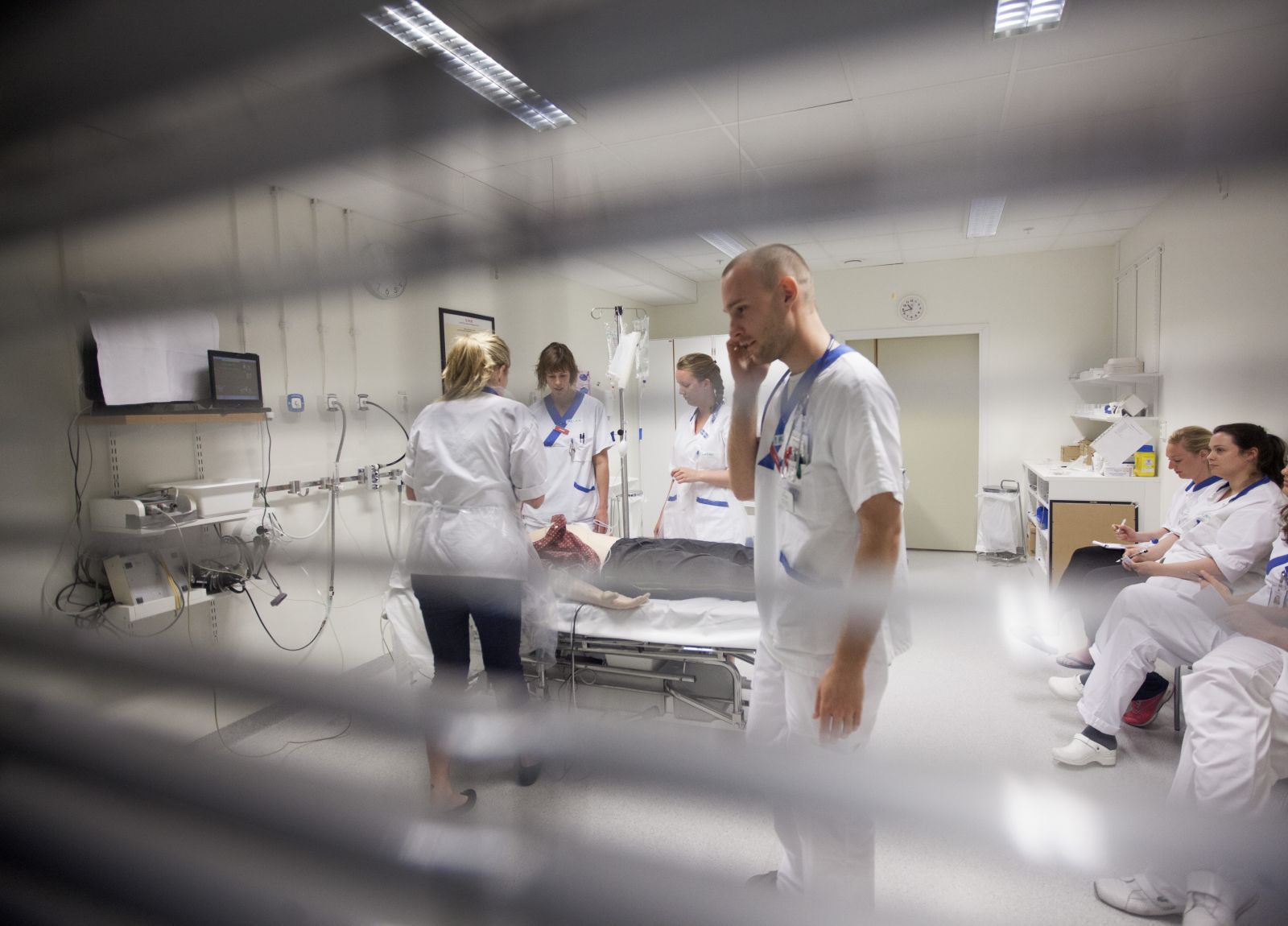



Theme
5JJ Interprofessional education 2
INSTITUTION
Medical student at University of Uppsala

Since 2011 Interprofessional Simulation Training (IPS) are a part of undergraduate medical- and nursing education at Uppsala University.
To evaluate the students capacity in teamwork and non-technical skills an assessment tool is needed, which has not yet been developed in Sweden.
Aim of the study:
To develope an instrument for evaluation of interprofessional teamwork with undergraduate healthcare students in Sweden.
Methods:
- Litterature re-view, excisting instruments.
- Translation of excisting instruments into Swedish.
- Validation by assessors viewing videorecorded scenarios.
- Survey and group interveiw with the participating assessors.
- Inter-rater reliability calculated from the results from the viewing of videorecorded scenarios.
Troughout the process we decided to form a new instrument that we named Up Beat, which is a tool based on instruments found in litterature and emended to better correspond with the curriculum used in IPS.
Cronbach’s Alpha for the Up Beat was 0,646 in the first version.
The participating assessors found it stimulating and appriciated using Up Beat during IPS.
After a few changes has been made, they fund it corresponding well with the curriculum for IPS for undergraduate medical- and nursing students.
There is many possible areas of use for Up Beat, including evaluation of team performance, measuring teamwork improvements in a team, enhancing students’ debriefing after team training, education for the simulation instructors and in the development of new team training scenarios.
Results confirms that Up Beat could go through a few changes to be more easy to use and to enhance reability.
A measurement instrument is a crucial to create a structured assessment of team performance.
A tool like Up Beat can be used as a development tool for both students and instructors during Interprofessional Simulation Training.
Undergraduate team training gain from using a validated assessment instrument.
Thank you to Martin Wohlin (MD, Senior Lecturer) and Jan Larsson (MD, PhD) for all the support and help during the study and writing, and to the simulation instructors working at Clinical Training Center at Akademiska Hospital of Uppsala.
1. Högskoleförordning (1993:100) [Internet]. 1993:100 feb 4, 1993. Hämtad från: https://lagen.nu/1993:100
2. Bandali K, Parker K, Mummery M, Preece M. Skills integration in a simulated and interprofessional environment: an innovative undergraduate applied health curriculum. J Interprof Care. mars 2008;22(2):179–89.
3. Wotton K, Davis J, Button D, Kelton M. Third-Year Undergraduate Nursing Students’ Perceptions of High-Fidelity Simulation. J Nurs Educ. november 2010;49(11):632–9.
4. Krüger A, Gillmann B, Hardt C, Döring R, Beckers SK, Rossaint R. [Teaching non-technical skills for critical incidents: Crisis resource management training for medical students]. Anaesthesist. juni 2009;58(6):582–8.
5. Sharp L. Effektiv kommunikation för säkrare vård. 1. uppl. Lund: Studentlitteratur; 2012. 125 p.
6. Powell SM, Kimberly Hill R. My copilot is a nurse—Using crew resource management in the OR. AORN J. januari 2006;83(1):178–202.
7. Cooper S, Cant R, Porter J, Sellick K, Somers G, Kinsman L, m.fl. Rating medical emergency teamwork performance: development of the Team Emergency Assessment Measure (TEAM). Resuscitation. april 2010;81(4):446–52.
8. Fletcher G, Flin R, McGeorge P, Glavin R, Maran N, Patey R. Anaesthetists’ Non-Technical Skills (ANTS): evaluation of a behavioural marker system. Br J Anaesth. maj 2003;90(5):580–8.
9. Malec JF, Torsher LC, Dunn WF, Wiegmann DA, Arnold JJ, Brown DA, m.fl. The mayo high performance teamwork scale: reliability and validity for evaluating key crew resource management skills. Simul Healthc J Soc Simul Healthc. 2007;2(1):4–10.
10. Guise J-M, Deering SH, Kanki BG, Osterweil P, Li H, Mori M, m.fl. Validation of a tool to measure and promote clinical teamwork. Simul Healthc J Soc Simul Healthc. 2008;3(4):217–23.
11. Sigalet E, Donnon T, Grant V. Undergraduate students’ perceptions of and attitudes toward a simulation-based interprofessional curriculum: the KidSIM ATTITUDES questionnaire. Simul Healthc J Soc Simul Healthc. december 2012;7(6):353–8.
12. Race P. Student Assessment in Higher Education: A handbook for assessing performance. Stud High Educ. 01 oktober 1999;24(3):390.
13. Organization WH, Safety WP. Patient safety curriculum guide: multi-professional edition [Internet]. 2011 [citerad 28 november 2013]. Hämtad från: http://apps.who.int/iris/handle/10665/44641?locale=fr
14. Oliver RG. A Handbook for Medical Teachers, 4th edn: David Newble, Robert Cannon Kluwer Academic Publishers, Dordrecht 2001 222 pages, hardback, 27 ISBN 0792370929. J Orthod. 01 juni 2003;30(2):168.
15. Vleuten CPMVD. The assessment of professional competence: Developments, research and practical implications. Adv Health Sci Educ. 01 januari 1996;1(1):41–67.
16. Van der Vleuten CPM, Schuwirth LWT. Assessing professional competence: from methods to programmes. Med Educ. mars 2005;39(3):309–17.
17. Haffling A-C, Beckman A, Edgren G. Structured feedback to undergraduate medical students: 3 years’ experience of an assessment tool. Med Teach. 2011;33(7):e349–357.
18. Tabachnick BG. Using multivariate statistics. 6th ed. Boston, Mass. ; London: Pearson Education; 2013. 983 p.
19. Wright MC, Phillips-Bute BG, Petrusa ER, Griffin KL, Hobbs GW, Taekman JM. Assessing teamwork in medical education and practice: relating behavioural teamwork ratings and clinical performance. Med Teach. januari 2009;31(1):30–8.
20. Salas E, DiazGranados D, Klein C, Burke CS, Stagl KC, Goodwin GF, m.fl. Does team training improve team performance? A meta-analysis. Hum Factors. december 2008;50(6):903–33.
21. Medical Teamwork and Patient Safety [Internet]. 2005 [citerad 15 mars 2014]. Hämtad från: http://www.ahrq.gov/research/findings/final-reports/medteam/index.html
22. Dunsford J. Structured communication: improving patient safety with SBAR. Nurs Womens Health. oktober 2009;13(5):384–90.
23. Manning ML. Improving clinical communication through structured conversation. Nurs Econ. oktober 2006;24(5):268–71.
24. Thomas CM, Bertram E, Johnson D. The SBAR communication technique: teaching nursing students professional communication skills. Nurse Educ. augusti 2009;34(4):176–80.
25. Kesten KS. Role-play using SBAR technique to improve observed communication skills in senior nursing students. J Nurs Educ. februari 2011;50(2):79–87.
26. O’Leary KJ, Thompson JA, Landler MP, Kulkarni N, Haviley C, Hahn K, m.fl. Patterns of nurse-physician communication and agreement on the plan of care. Qual Saf Health Care. juni 2010;19(3):195–9.
27. Kolbe M, Burtscher MJ, Wacker J, Grande B, Nohynkova R, Manser T, m.fl. Speaking Up Is Related to Better Team Performance in Simulated Anesthesia Inductions: An Observational Study. Anesth Analg. november 2012;115(5):1099–108.
28. Nunnally JC, Bernstein IH. Psychometric theory. New York: McGraw-Hill; 1994.
29. Cortina JM. What is coefficient alpha? An examination of theory and applications. J Appl Psychol. 1993;78(1):98–104.
30. Streiner DL. Starting at the beginning: an introduction to coefficient alpha and internal consistency. J Pers Assess. februari 2003;80(1):99–103.
 Send Email
Send Email